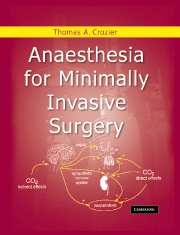Book contents
- Frontmatter
- Contents
- Preface
- Foreword
- Acknowledgements
- 1 Introduction
- 2 Physiology
- 3 Preparing and positioning for laparoscopic surgery
- 4 Monitoring
- 5 Anaesthesia for laparoscopic surgery
- 6 Complications and contraindications of laparoscopic surgery
- 7 Post-laparoscopy pain and pain relief
- 8 Laparoscopic bariatric surgery
- 9 Minimally invasive thoracic surgery
- 10 Laser surgery of the upper aerodigestive tract
- 11 Minimally invasive neurosurgery
- Index
8 - Laparoscopic bariatric surgery
Published online by Cambridge University Press: 21 October 2009
- Frontmatter
- Contents
- Preface
- Foreword
- Acknowledgements
- 1 Introduction
- 2 Physiology
- 3 Preparing and positioning for laparoscopic surgery
- 4 Monitoring
- 5 Anaesthesia for laparoscopic surgery
- 6 Complications and contraindications of laparoscopic surgery
- 7 Post-laparoscopy pain and pain relief
- 8 Laparoscopic bariatric surgery
- 9 Minimally invasive thoracic surgery
- 10 Laser surgery of the upper aerodigestive tract
- 11 Minimally invasive neurosurgery
- Index
Summary
Bariatrics is the branch of medicine that deals with obese patients and their problems, but mainly with their weight itself. The term bariatics comes from the Greek βαρνσ (barys) meaning “heavy” and a derivative of the word ιατρεια (iatreia) which means “healing”, as in paediatrics and geriatrics.
Morbid obesity used to be a typical relative contraindication for laparoscopic surgery. Now it is an indication of its own. The intention of bariatric surgery is to enable morbidly obese patients to lose weight that they are unable to lose by conservative means. The procedures used in bariatric surgery are not simple weight reduction methods, such as liposuction, that work by directly removing excess fatty tissue. Bariatric surgery takes a more complex approach that modifies the gastrointestinal system in such a manner as to make it almost impossible for the patient to maintain his or her weight at a high level. Weight reduction surgery has been performed since the 1960s as a measure of last resort to enable morbidly obese patients to lose weight. Conventional surgery in these patients is fraught with a wide array of potentially lethal complications ranging from pulmonary embolism and pneumonia to poor wound healing and wound infection. Laparoscopic techniques are the obvious solution to these problems and have been used in bariatric surgery since 1993. The intraoperative course can be turbulent during laparoscopic procedures, but recovery is more rapid with fewer complications.
- Type
- Chapter
- Information
- Anaesthesia for Minimally Invasive Surgery , pp. 99 - 120Publisher: Cambridge University PressPrint publication year: 2004



